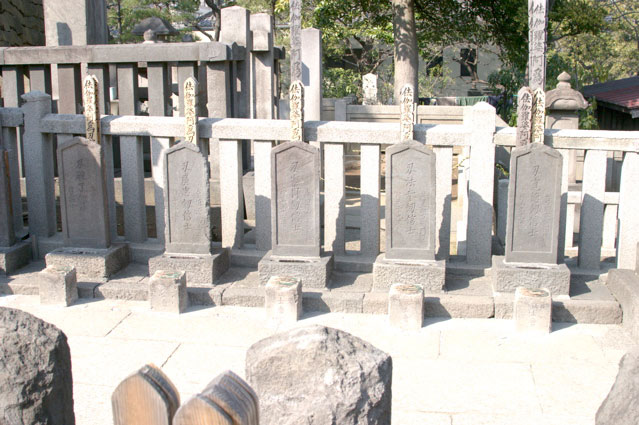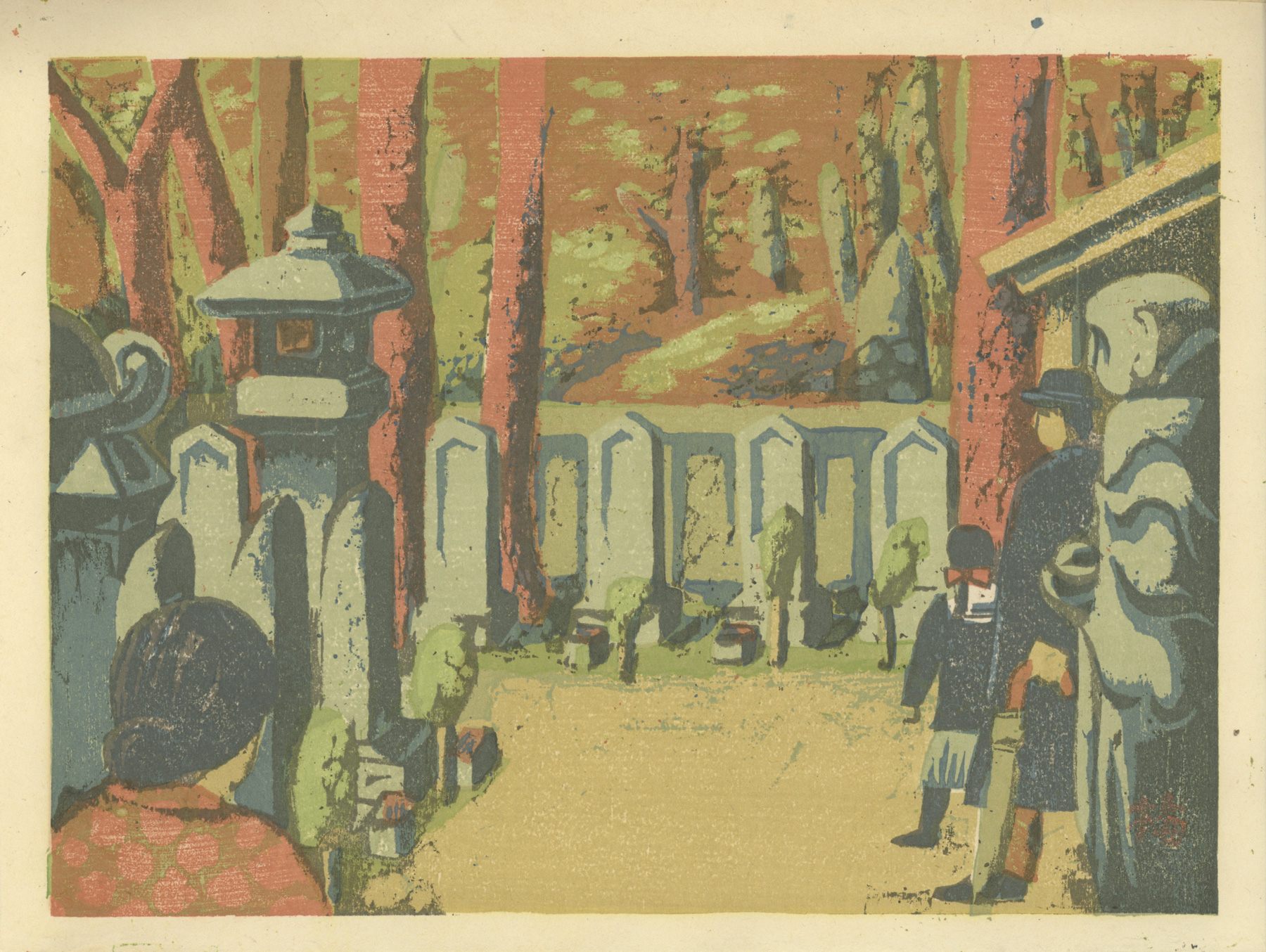Source: Japanese Prints During the Allied Occupation 1945 – 1952, Lawrence Smith, The British Museum Press, 2002, p.24
In reference to the 15 print series Scenes of Last Tokyo, Smith points out that six of the series depicted "places with serious imperial resonances," the six being the Nijubashi Bridge at the Imperial Palace, the Akasaka Palace (residence of the Crown Prince), the Meiji Shrine, the Torii (Gateway) at Kudan, the Gate of the Imperial University (alma mater of the most senior bureaucrats of the militarist era), and the Graveyard of Sengaku-ji, burial place of Japan’s most celebrated paragons of loyalty. It is one of seven prints in the series created from new designs rather than from original or recut blocks from the series Shin Tokyo Hyakkei (One Hundred Views of New Tokyo.)
In reference to the 15 print series Scenes of Last Tokyo, Smith points out that six of the series depicted "places with serious imperial resonances," the six being the Nijubashi Bridge at the Imperial Palace, the Akasaka Palace (residence of the Crown Prince), the Meiji Shrine, the Torii (Gateway) at Kudan, the Gate of the Imperial University (alma mater of the most senior bureaucrats of the militarist era), and the Graveyard of Sengaku-ji, burial place of Japan’s most celebrated paragons of loyalty. It is one of seven prints in the series created from new designs rather than from original or recut blocks from the series Shin Tokyo Hyakkei (One Hundred Views of New Tokyo.)
Sengaku-ji Temple (泉岳寺)
Source: Japan Guide.com website http://www.japan-guide.com/e/e3000.html
Sengakuji is a small temple in Minato-ku, Tokyo, famous for its graveyard where the "47 Ronin" (also known as Akoroshi, the "masterless samurai from Ako") are buried.
The story of the 47 loyal ronin (see below) remains one of the most popular historical stories in Japan, and many people visit the temple in order to pay respect to the Akoroshi by burning incense sticks (senko) in the graveyard. A small museum commemorating the 47 ronin can also be found at Sengakuji.
December 14 is the anniversary of the 47 ronin's avenge. A festival is held annually at Sengakuji to commemorate the event, attracting thousands of visitors. The small graveyard becomes very crowded and smoky during the festival, and many typical festival foods such as Okonomiyaki and Takoyaki can be enjoyed at temporarily constructed food stands.

In March 1701, lord Asano Takuminokami of Ako (today's Hyogo Prefecture) attacked lord Kira Hozukenosuke at Edo castle. Asano lost patience after repeatedly being provoked and treated arrogantly by Kira, but failed to kill him in the attack. On the same day, Asano was sentenced to commit seppuku (ritual suicide), while Kira was not punished at all, despite the contemporary custom of punishing both parties in similar incidents. In addition, the whole Asano family was removed from power, leaving Asano's samurai without a job and a strong will to avenge their unfairly punished master.
For over one and a half year, the samurai prepared the avenge under difficult circumstances. On December 14, 1702, the remaining group of 47 ronin under their leader Oishi Kuranosuke finally succeeded to avenge their master by killing lord Kita in his mansion. Afterward, they carried Kira's head to Sengakuji, and were later sentenced to commit seppuku.
The story of the 47 ronin became highly popular as a kabuki play during the Edo Period, and remains very popular today in Japan where loyalty, endurance and will power are some of the most respected characteristics.
The story of the 47 loyal ronin (see below) remains one of the most popular historical stories in Japan, and many people visit the temple in order to pay respect to the Akoroshi by burning incense sticks (senko) in the graveyard. A small museum commemorating the 47 ronin can also be found at Sengakuji.
December 14 is the anniversary of the 47 ronin's avenge. A festival is held annually at Sengakuji to commemorate the event, attracting thousands of visitors. The small graveyard becomes very crowded and smoky during the festival, and many typical festival foods such as Okonomiyaki and Takoyaki can be enjoyed at temporarily constructed food stands.

The Story of the 47 Ronin
Source: Japan Guide.com website http://www.japan-guide.com/e/e3000.htmlIn March 1701, lord Asano Takuminokami of Ako (today's Hyogo Prefecture) attacked lord Kira Hozukenosuke at Edo castle. Asano lost patience after repeatedly being provoked and treated arrogantly by Kira, but failed to kill him in the attack. On the same day, Asano was sentenced to commit seppuku (ritual suicide), while Kira was not punished at all, despite the contemporary custom of punishing both parties in similar incidents. In addition, the whole Asano family was removed from power, leaving Asano's samurai without a job and a strong will to avenge their unfairly punished master.
For over one and a half year, the samurai prepared the avenge under difficult circumstances. On December 14, 1702, the remaining group of 47 ronin under their leader Oishi Kuranosuke finally succeeded to avenge their master by killing lord Kita in his mansion. Afterward, they carried Kira's head to Sengakuji, and were later sentenced to commit seppuku.
The story of the 47 ronin became highly popular as a kabuki play during the Edo Period, and remains very popular today in Japan where loyalty, endurance and will power are some of the most respected characteristics.
Print Details
| IHL Catalog | #173 |
| Title or Description | Graveyard at Sengakuji 泉岳寺墓所 Sengakuji bosho |
| Series | Scenes of Last Tokyo [also seen translated as Recollections of Tokyo] 東京回顧図会 Tokyo kaiko zue |
| Artist | Azechi Umetarō (1902-1999) |
| Signature | Ume (lower right-hand corner of print image) |
| Seal | none |
| Publication Date | 1945 |
| Edition | 1945 |
| Publisher | Fugaku Shuppansha 富岳出版社, Tokyo, Uemura Masurō 上村益郎 publisher |
| Carver | |
| Printer | Hirai Kōichi 平井孝一 |
| Impression | excellent |
| Colors | excellent |
| Condition | excellent- printer's ink spotting in margins. Attached to original presentation folder |
| Genre | sosaku hanga (creative print) |
| Miscellaneous | One of the seven newly created prints in this series of 15 prints. |
| Format | chuban |
| H x W Paper | 7 7/8 x 10 1/5 in. (20 x 26.7 cm) |
| H x W Image | 7 x 9 1/2 in. (17.8 x 24.1 cm) |
| Collections This Print | Carnegie Museum of Art 89.28.709.1; British Museum 1980,1227,0.18.13; Los Angeles County Museum of Art M.81.267.30; Museum of Fine Arts, Boston 65.1089; Mead Art Museum at Amherst College 2008.63.13; Smithsonian Freer Gallery of Art and Arthur M. Sackler Gallery S1995.118.11; University of Alberta Art Collection 2007.3.1; Portland Art Museum 1996.31.2m |
| Reference Literature | The Artist's Touch, The Craftsman's Hand: Three Centuries of Japanese Prints from the Portland Art Museum, Maribeth Graybill, Portland Art Museum, Oregon, 2011, p. 302; Japanese Prints During the Allied Occupation 1945-1952, Lawrence Smith, British Museum Press, 2003, mentioned on p.24; Made in Japan - The Postwar Creative Print Movement, Alicia Volk, Milwaukee Art Museum, 2005, referenced on p. 35; Modern Japanese Prints: The Twentieth Century, Amanda T. Zehnder, Carnegie Museum of Art, 2009, p. 22. |


